DESCRIPTION OF PROBLEM
Broilers have specific essential amino acid requirements that must be met in order to support growth, muscle development, and meat yield (Mack et al., 1999; Zampiga et al., 2018). Continued genetic selection of broiler strains focused on increasing feed intake and meat yield and improving growth efficiency will require adjustments in formulation, particularly in amino acids, in order to adjust for shorter rearing periods to a common body weight. In addition to body composition changes attributed to genetic selection, changes or adjustments in management practices and bird health status can also influence nutrient requirements.
Being uricotelic, chickens lack most of the enzymes involved in the urea cycle, which does not allow for the biosynthesis of arginine from ammonia and ornithine, and this results in an increased arginine requirement when compared to other species. Therefore, chickens rely on dietary amino acid sources to fulfill their arginine requirement (Tamir and Ratner, 1963). Arginine is an essential amino acid for broilers, known for its direct influence in growth (Cuca and Jensen, 1990; Kidd et al., 2001; Corzo et al., 2003), immunity (Collier and Vallance, 1989), tissue healing (Efron and Barbul, 1998), and carcass traits (Corzo et al., 2003; Fernandes et al., 2009; Khajali and Wideman, 2010). In fact, arginine is one of the most versatile amino acids as it is involved in diverse physiological functions, and serves as a substrate for the biosynthesis of molecules such as nitric oxide, creatine, glutamine, glutamate, and ornithine (Khajali and Wideman, 2010). Thus, changes in body composition could potentially affect the arginine needs of modern commercial broilers. Studies have been conducted to evaluate optimum arginine values particularly during short periods of broiler growth (Baker, 1994; Mack et al., 1999; Corzo, 2012; Mejia et al., 2012). However, there is a need to conduct these studies by employing modern commercial broilers, and to encompass periods that surpass the starter feed phase. It is also important to remember the diverse functionality of arginine, which is likely to modify the digestible arginine (dArg) to digestible lysine (dLys) ratio due to a number of factors such as experimental and environmental conditions, diet type, and broiler strains among others (Mack et al., 1999; Kidd et al., 2001).
More recently, arginine has drawn attention for its ability to improve meat quality through reductions in the occurrence of some breast meat abnormalities to include wooden breast (Bodle et al., 2018), spaghetti meat, and white striping (Zampiga et al., 2019) when included in the diet at levels higher than those recommended by breeding companies. Both of these authors attributed this benefit to a possible increase in the production of nitric oxide through enhanced vasodilation, improved blood flow, and limiting muscle damage with greater oxygen supply to the muscle fibers. Interestingly, during these studies investigating the impact of meat quality, improvement in growth performance was also reported (Bodle et al., 2018; Zampiga et al., 2018) with arginine levels higher than typically recommended values. These observations combined with the lack of recent comprehensive arginine requirement assessments and its optimum ratio to lysine merit investigation, and therefore the objective of this study was to determine the optimum dArg/dLys value for study periods from 1 to 14 d, 1 to 25 d, and 25 to 42 d in Yield Plus Male (YPM) x Ross 708 males.
MATERIALS AND METHODS
The poultry experiments reported herein were reviewed and approved by the Department of Veterinary Services of Aviagen North America. The birds were cared for according to the National Chicken Council Animal Welfare for Broiler Chickens Standards (NCC, 2005) and the Poultry Science Association Guide for the Care and Use of Agricultural Animals in Research and Teaching.
Experimental Diets
Samples of major protein contributing ingredients (corn, wheat middlings, soybean meal, corn gluten meal, and poultry meal) were collected and analyzed for proximate and total amino acid composition prior to formulation of the diets. Digestibility coefficients used for the major ingredients were obtained from the Brazilian broiler nutrient requirement tables (Rostagno et al., 2011). Upon receiving these nutrient analyses of the raw materials, the formulation matrix for each ingredient was updated using analyzed values, and then the experimental diets were formulated. During all phases of evaluation, all nutrients were formulated to meet Aviagen recommendations (Aviagen, 2019), except for lysine which was formulated to 95% of the Aviagen recommendations (Aviagen, 2019), and arginine, which was the amino acid being evaluated. The calculated dArg/dLys value was formulated during all feeding phases studies to have a minimum level of 77, and 10-point increments were added to the basal diet in the form of L-arginine at the expense of an inert filler (sand). As a result, 6 incremental dArg/dLys levels were fed during the phases evaluated. The first phase (starter) was provided to the birds in crumbled form from hatch until 14 d of age, while the grower and finisher feed phases were provided in pelleted form up to 25 and 42 d of age, respectively. Feeds were manufactured at the Auburn University pilot feed mill. A major basal mix was made for each feed phase being evaluated, and equal aliquots from those basal mixes were then blended with the corresponding level of supplemental L-arginine. Feed samples from finished feeds were collected and analyzed for total amino acid concentration in order to validate the proximity to target levels. Calculated and analyzed total lysine and arginine values are displayed in Table 1. Crude protein was determined using the combustion method (AOAC 992.15) and the amino acid concentration of raw materials and finished feeds was determined using acid hydrolysis (AOAC 982.30) for most amino acids. Methionine and cysteine were determined by AOAC 994.12 and tryptophan by AOAC 988.15 methodology.
Table 1. Ingredient and nutrient composition of dietary treatments fed to YPM 3 Ross 708 male broilers from 1 to 25 d of age (experiment 1) and 25 to 42 d of age (experiment 2).
Table 2. Growth performance of YPM x Ross 708 male broilers fed diets varying in dArg/dLys ratio from 1 to 14 and 1 to 25 d of age, experiment 1.1
Experimental Design and Bird Management
Experiment 1. A total of one thousand and eighty 1-day-old male chicks was obtained from a parent stock flock (YPM x Ross 708) of 38 wk of age. Immediately after hatch, chicks were sorted by quality and vent-sexed, and randomly placed in 72 floor pens (approximately 1.40 cm2 ). The treatments consisted of 6 dArg/dLys levels, with 12 replicate pens each containing 15 chicks and sorted in a randomized block design. The second phase of experiment 1 was a cumulative dArg/dLys study between 1 and 25 d of age, considering that the grower phase (14–25 d) was not studied independently from the starter period, and the dArg/dLys levels used during the starter phase were maintained and carried over into the grower period. Body weights were measured at placement, and 14 and 25 d of age by bulk weighing each pen. The average BW of each pen was calculated by dividing the total weight of all the birds within the pen by the number of birds within that pen. Residual feed was weighed at 14 and 25 d of age, and livability was calculated as the percentage of unviable to viable birds. Mortality was weighed daily and used to adjust the feed conversion ratio (FCR).
Experiment 2. A total of one thousand one hundred and fifty two 1-day-old male chicks was obtained from the same YPM x Ross 708 parent stock flock as in experiment 1, and equally allocated in 72 floor pens, with 16 chicks per pen under the same management guidelines described in experiment 1. Birds received a common starter (crumbles) and grower (pellets) feed formulated to meet or exceed Aviagen nutrient recommendations (Aviagen, 2019), until 25 d of age (Table 1). At 25 d of age, the number of birds in each pen was equalized to 14, and the pen BW was determined. All birds at 25 d of age within ± 100 g of the overall BW mean were included; all other birds above or below this range were discarded. As mentioned previously, birds during the finisher phase received common starter and grower feeds based on corn, soybean meal, and poultry meal to represent diets typically used in broiler feeds during these periods (Table 1).
At hatch, each chick was administered a subcutaneous injection of the following viral vaccine: full dose of a Marek’s with an antibiotic (gentamicin), one-half dose of reovirus, full dose of infectious laryngotracheitis, and a full dose of fowl pox vaccines. In addition, each chick was administered, via a spray cabinet, one-half dose of a Newcastle and bronchitis vaccine and a full dose of a coccidiosis vaccine.
In both experiments, birds were housed in an environmentally controlled facility. The number of birds per pen was less than or equal to the density (41.5 kg/m2) stipulated by the National Chicken Council welfare guidelines (NCC, 2005) for the duration of the trial. Throughout the first 7 d after hatch, birds were subjected to 23 h of light (26.9 lux, 2.5 foot candles), and then subsequently 18 h of light (10.8 lux, 1.0 foot candle) for the remainder of the studies. Ambient temperatures were controlled as follows: 31ºC to 29ºC from 1 to 7 d, 29ºC to 27ºC from 7 to 14 d, 27ºC to 24ºC from 14 to 21 d, 24ºC to 22ºC from 21 to 28 d, 22ºC to 21ºC from 28 to 35 d, and 21ºC to 20ºC thereafter. Ambient temperature was measured 15 cm above the head of the chickens. Ad libitum access to water was provided via mini-drinkers placed in each pen throughout the first 7 d after hatch and individual nipple drinker lines throughout the trials. Feed was available throughout the study with supplemental feeder trays placed in each pen throughout the first 7 d after hatch and a single 33 cm tube feeder located in the center of each pen.
Figure 1. dArg/dLys ratio for optimization of feed conversion (corrected for mortality weight) of YPM x Ross 708 male broilers from 1 to 14 d of age, experiment 1. Abbreviations: dArg, digestible arginine; dLys, digestible lysine; FCR, feed conversion ratio; YPM, Yield Plus Male.
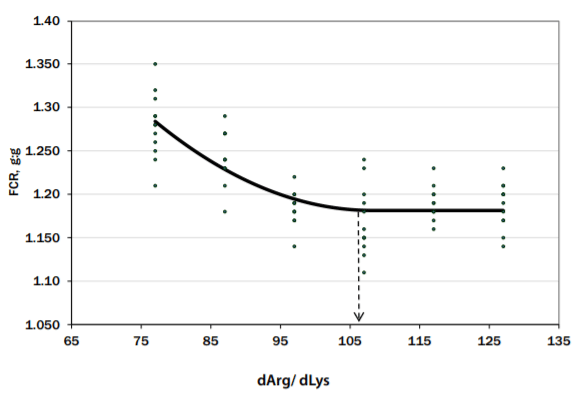
In experiment 2 (finisher phase), all birds were processed and carcass traits measured. All the birds were individually wing banded approximately 24 h prior to processing, and feed was removed from all pens approximately 12 h before processing. Birds had access to water during the feed removal period. Birds were then transported to the processing plant at Aviagen’s Product Development Center. All data collected on each bird at the processing plant were recorded corresponding to the individual wing band number. For calculation of yields, individual live BW was measured upon arrival at the processing plant. Birds were stunned, exsanguinated, scalded, and plucked according to standard commercial operating procedures. The carcasses were eviscerated and air chilled for approximately 24 h prior to deboning. Thigh, pectoralis major, and pectoralis minor were removed from the carcass and their weights were recorded. Total breast weight was measured by adding the total weight of boneless-skinless pectoralis major and pectoralis minor muscles.
Figure 2. dArg/dLys ratio for optimization of feed conversion (corrected for mortality weight) of YPM x Ross 708 male broilers from 1 to 25 d of age, experiment 1. Abbreviations: dArg, digestible arginine; dLys, digestible lysine; FCR, feed conversion ratio; YPM, Yield Plus Male.
Table 3. Growth performance of YPM x Ross 708 male broilers fed diets varying in dArg/dLys ratio from 25 to 42 d of age, experiment 2.1
Statistical Analysis
Each experiment was designed as a randomized complete block with 12 replications per treatment. Live performance data (BW gain, FCR, feed intake, livability) were collected and determined from all pens at 14 and 25 d (experiment 1), and 25 and 42 d (experiment 2) of age. Blocks were assigned according to different locations within the house. Each group of pens was considered a random block, while pen was considered the experimental unit. Optimum dArg/dLys was estimated via quadratic broken line regression because of adequacy of fit compared to other regression types. Linear broken line, quadratic broken line, and quadratic polynomial models were constructed on the data. Quadratic broken line was determined to be the best-fit model of the data based on R2 and thus optimum ratios for data were based on this model. The NLIN procedure of SAS 9.4 (SAS Institute, Cary, NC) as described by Robbins et al. (2006) was used to determine these estimates. The regression to determine dArg/dLys optimums was estimated using the analyzed total arginine and lysine content, and subsequently adjusted to the digestibility of the basal mix. This was done by adjusting the analyzed total arginine and lysine values of the basal mix and multiplying them by the calculated digestible estimate for each amino acid relative to the calculated total estimate for that specific basal, thus taking under consideration the contribution from different feedstuffs which all contained different amino acid digestibilities.
RESULTS AND DISCUSSION
Table 1 shows a close agreement between the formulated and analyzed values, as expected from prior amino acid analyses of feedstuff. Diets were formulated to 95% of the recommended dLys requirements (Aviagen, 2019) to prevent overconsumption of dLys, and to ensure dArg would only be biologically efficient up to the slightly suboptimal lysine level, in turn providing a closer estimation of the optimum dArg/dLys value. Lysine, which is the reference amino acid when applying the balanced protein concept in formulation (Baker and Han, 1994), was analyzed for total concentration at 1.32% (1.37% calculated), 1.17% (1.22% calculated), and 1.08% (1.10% calculated) for the starter, grower, and finisher experimental feed periods. Total arginine analyzed in the experimental feeds was 0.96, 0.87, and 0.81% in the starter, grower (experiment 1), and finisher (experiment 2) feed phases, respectively. The analyzed level of total arginine was also in close agreement with the respective calculated values of 1.02, 0.90, and 0.81%. To these analyzed total values for lysine and arginine, a digestibility coefficient for each of the final feeds was included and the resultant calculated dArg/dLys value was estimated to be 75, 78, and 79 for the starter, grower, and finisher basal feeds, respectively. Analysis of free arginine confirmed the accurate addition of L-arginine in all dose levels.
Table 4. Carcass characteristics of YPM x Ross 708 male broilers fed diets varying in dArg/dLys ratio from 25 to 42 d of age, experiment 2.1
Experiment 1 (1–14 d of age and 1–25 d of age)
Progressive additions of dArg increased BW gain and decreased FCR from 1 to 14 d of age (Table 2). As expected from the formulation, total dArg intake increased with gradient additions of L-arginine from 1 to 14 d of age. Broilers consumed 5.53 g of dArg from 1 to 14 d when provided diets formulated to contain a dArg/dLys value of 107. Broilers fed a diet with dArg/dLys of 77 had 58 g lower BW gain and 11-point higher FCR, compared to broilers fed a diet containing a dArg/dLys ratio of 107. For BW gain and FCR (Figure 1) from 1 to 14 d, the optimum dArg/dLys ratio determined via quadratic broken line methodology for both variables was 106. In agreement, Corzo (2012) reported a dArg/dLys ratio of 108 for BW gain from 0 to 18 d post hatch, and a higher ratio of 114 to optimize FCR. Baker and Han (1994) determined an optimum dArg/dLys of 105 in male crossbreed chicks (New Hampshire x Columbian) during the first 3 wk post hatching
A similar response was observed for the period encompassing 1 to 25 d of age as progressive increments of dArg/dLys ratio resulted in increased BW gain and decreased FCR. Intake of dArg increased from 11.82 to 21.31 g as the dArg/dLys increased from 77 to 127 from 1 to 25 d of age. Broilers fed diets with a dArg/ dLys ratio of 107 from 1 to 25 d had 236 g higher BW gain and 20-point lower FCR, when compared with broilers fed the 77 dArg/dLys treatment diet. Optimum ratios from 1 to 25 d of age for BW gain and FCR (Figure 2) were determined to be 105 and 108, respectively. This optimum for BW gain is similar to previous findings; Corzo (2012) reported an optimum dArg/dLys for BW gain and FCR of 108 and 114, respectively, in Ross 708 chicks from 1 to 18 d of age. The relationship between the optimum requirement for BW gain and FCR is different from what has been reported in previous studies (Labadan et al., 2001; Chamruspollert et al., 2002), where a higher requirement for FCR than for BW gain was observed.
Figure 3. dArg/dLys ratio for optimization of feed conversion of YPM x Ross 708 male broilers from 25 to 42 d of age, experiment 2. Abbreviations: dArg, digestible arginine; dLys, digestible lysine; FCR, feed conversion ratio; YPM, Yield Plus Male.
Experiment 2 (25–42 d of Age)
Regression analyses during this phase was not as precise as the 2 previous phases likely due to an increase in experimental variability of these older broilers (Tables 3 and 4). However, in parallel with the first 2 experimental periods studied herein, treatment mean values showed an increase in BW gain and decrease in FCR as dArg/dLys increased in broilers from 25 to 42 d of age (Table 3). The intake of dArg increased from 24.94 to 41.68 g as dArg/dLys increased from 79 to 129. During the experimental period, broilers fed the dietary treatment with dArg/ dLys of 79 had 182 g had lower BW gain and an 18-point higher FCR, when compared to birds fed the 129 treatment. Optimum dArg/dLys values for the experimental period for BW gain and FCR (Figure 3) were determined to be 129 and 116, respectively. In contrast with the findings in experiment 1 and other authors, optimum dArg/dLys was higher for BW gain than for FCR during this period. However, results for FCR during the finisher phase had a similar optimum ratio to that reported by Mack et al. (1999) who suggested a dArg/dLys value of 112 in male broilers during a similar experimental period (20–40 d) to that used in the present study. Feed intake was not influenced by the dietary treatments provided.
Carcass Characteristics
Carcass yield exhibited a quadratic increase as dArg/dLys increased (Table 4). The dArg/ dLys value needed to optimize carcass yield was determined to be 136. Previous findings by Corzo et al. (2003) determined an optimization of the chilled carcass weight and live performance at 1.00% arginine with a dArg/dLys of 115. Thigh weight and yield did not show a statistical fit for a quadratic broken line modeling; so linear regression was assessed and found to be significant (P < 0.001), and showed an increase in both variables with progressive increments of dArg/dLys (Figure 4). The reason behind this increase in the absolute and relative weight of thigh muscles remains unknown, but it can be hypothesized that the role of arginine in creatine biosynthesis, among many others, may have been responsible for this effect. Previously, Chamruspollert et al. (2002) reported an increase in muscle creatine when birds were supplemented with L-arginine, whereas Al-Daraji and Salih (2012) reported a considerable increase in thigh yield of Ross 308 broilers as arginine was supplemented to the feed.

Figure 4. Thigh absolute and relative weights at 42 d of age, in YPM x Ross 708 male broilers, after being fed varying levels of dArg/dLys from 25 to 42 d of age, experiment 2. Abbreviations: dArg, digestible arginine; dLys, digestible lysine; YPM, Yield Plus Male.
Breast weight and yield displayed a quadratic increase with progressive increments in dArg/ dLys, and estimated the optimums to be at 112 and 109, respectively. The values obtained in this trial were higher than those obtained by Labadan et al. (2001), who reported an arginine and lysine requirement of 0.83 and 0.81% of the diet, respectively, to optimize breast muscle weight in broilers from 5 to 8 wk of age. However, the continued selection of genetic lines has resulted in higher efficiency broiler genetic strain crosses with higher observed breast yields and lower content of adipose tissue. These genetic changes are likely to have influenced such increases in amino acid needs to optimize breast yield and weight. In general, previous research trials have shown that increased arginine supplementation throughout the feeding programs of broilers has a positive impact on live performance and carcass absolute and relative weights. In a more recently published report that used current commercial high yielding strains, Zampiga et al. (2018) reported that increasing dArg/dLys from 105 to 115 in broiler chicks from 1 to 43 d reduced cumulative FCR from 1.675 to 1.646 and increased BW gain by 50 g. Similarly, Bodle et al. (2018) reported a reduction of 2 points in feed conversion and an increase of 40 g in BW gain through 36 d of age when increasing this ratio by 10 points over the control diet. As observed in this study and that reported by Kidd and Tillman (2016), the dArg/dLys ratio increases as the bird matures, and is likely associated to increases in bird maintenance needs for other essential amino acids, coupled with a possible higher concentration of arginine in body tissues in the aging bird.
CONCLUSIONS AND APPLICATIONS
1. The optimum dArg/dLys value to optimize BW gain and FCR from 1 to 14 d was 106 for both parameters, and 105 and 108 from 1 to 25 d of age, respectively.
2. The optimum dArg/dLys needed to optimize BW gain and FCR from 25 to 42 d was determined to be 129 and 116, respectively.
3. Carcass yield, breast weight, and breast yield were optimized in broilers fed digestible dArg/dLys of 136, 112, and 109, respectively, while thigh weight and yield increased linearly and may require higher dArg/dLys values to achieve an optimum response.
4. Higher dArg/dLys needs as the bird ages are likely due to the considerably high maintenance value of arginine in broilers.
DISCLOSURES
The authors declare no conflicts of interest.

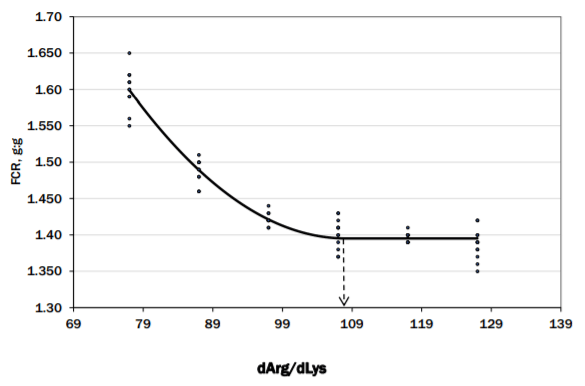
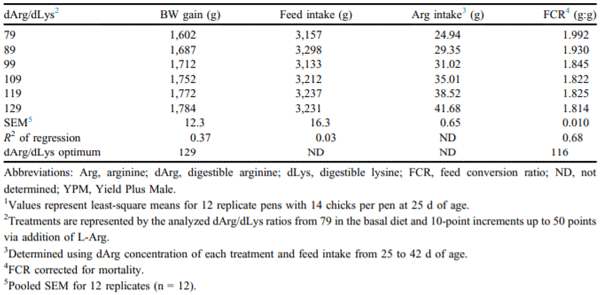



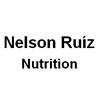



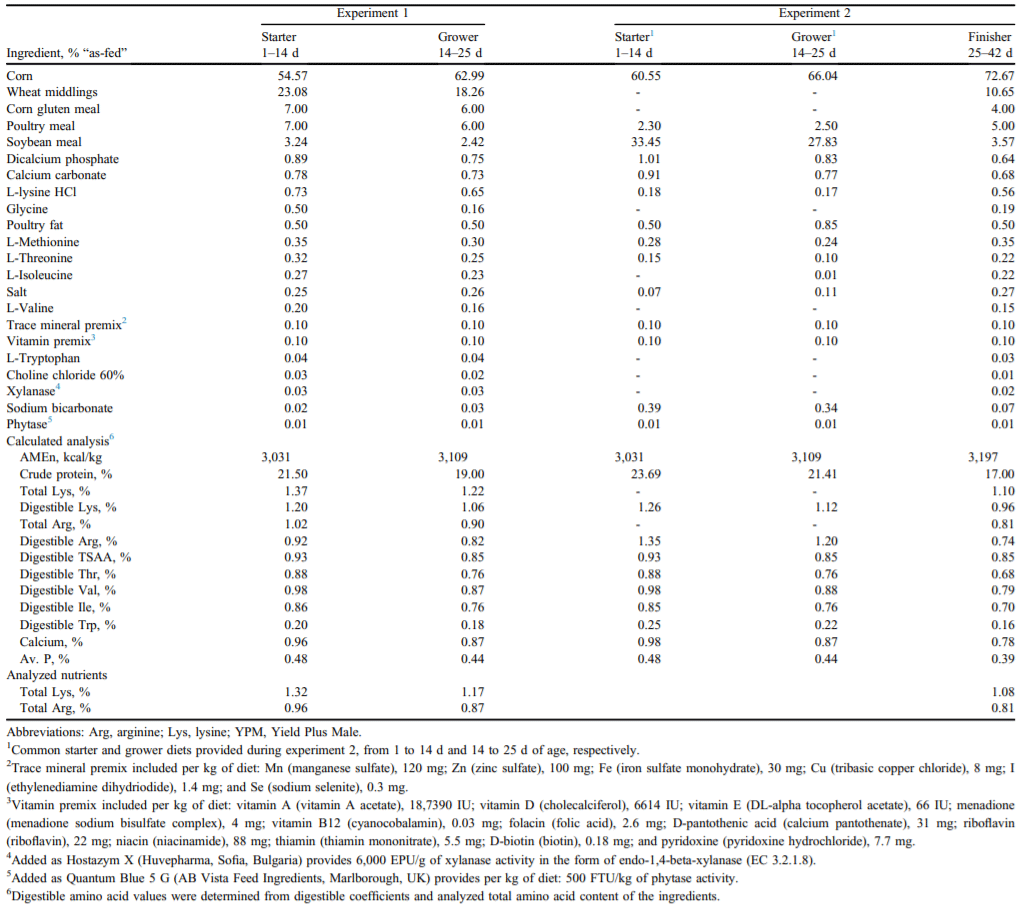











.jpg&w=3840&q=75)





